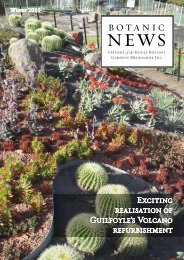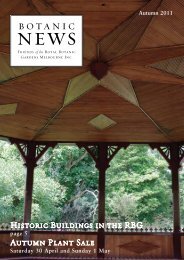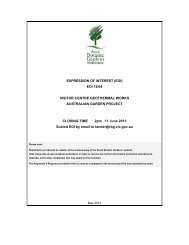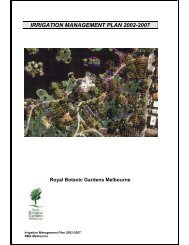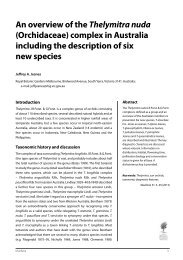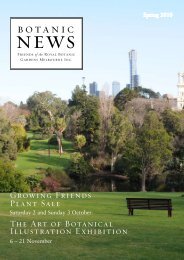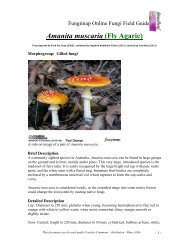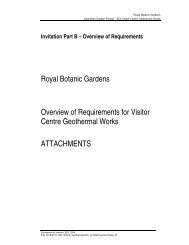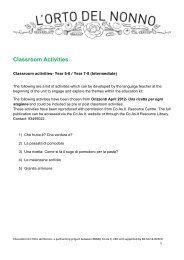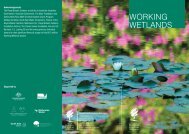Annual Report 2010-2011 (PDF - 2.47 mb) - Royal Botanic Gardens ...
Annual Report 2010-2011 (PDF - 2.47 mb) - Royal Botanic Gardens ...
Annual Report 2010-2011 (PDF - 2.47 mb) - Royal Botanic Gardens ...
Create successful ePaper yourself
Turn your PDF publications into a flip-book with our unique Google optimized e-Paper software.
Contents<br />
OUR achievements – Strategic Priority 2C<br />
Business Plan specific outcomes<br />
(and associated Corporate Plan actions)<br />
Progress against specific outcomes and actions<br />
Specific Outcome 34<br />
Display wild-collected Victorian plant species at<br />
RBG Melbourne to benefit conservation and<br />
community awareness and to conserve water<br />
resources by reducing irrigation through use of<br />
indigenous species.<br />
Additional wild-collected Victorian plant species<br />
have been introduced into the landscape including<br />
additional planting into the Rare and Threatened<br />
Species Beds, Australian Forest Walk, Herbarium<br />
Bed and Conifer Border.<br />
Specific Outcome 35<br />
Advance the integrated conservation of plant<br />
biodiversity, with an emphasis on management<br />
and eradication of, and education about,<br />
environmental weeds.<br />
Specific Outcome 36<br />
Continue implementation of the RBG Cranbourne<br />
remnant vegetation management program, including<br />
woody and herbaceous weed management, and<br />
prescribed burns covering six hectares annually.<br />
Specific Outcome 37<br />
Implement year four of the Grassy Woodland<br />
grassy weed control program.<br />
Through collaboration with colleagues in<br />
the USA, Switzerland, Chile, and the Canary Islands,<br />
a global analysis of invasive species of mountains<br />
has been identified and several papers published by<br />
the group MIREN (Mountain Invasions Research<br />
Network). This work has the potential to identify<br />
species likely to become problematic should<br />
they establish in Australian montane and alpine<br />
vegetation, allowing for sensible targeting of<br />
eradication effort.<br />
The grassy weed control program continued to be a<br />
focus (see Specific Outcome 37 below), as did the<br />
control of disturbance-loving taxa such as Inkweed,<br />
thistles and Nightshade within sites of recent<br />
prescribed burns. Control of highly invasive species<br />
site-wide included Blackberry, Sallow Wattle, Sweet<br />
Pittosporum, Sweet Vernal Grass and Kikuyu.<br />
Three prescribed burn sites were prepared and burn<br />
plans completed and approved. Two prescribed<br />
burns were conducted, totalling 17 hectares. These<br />
burns were located to the south-west of RBG<br />
Cranbourne’s entrance and north-east of the<br />
Australian Garden Stage 2.<br />
An integrated control program of grassy weeds, in<br />
particular Sweet Vernal Grass, within the highly<br />
significant and diverse Grassy Woodland Ecological<br />
Vegetation Class continued to be a management focus.<br />
page 78




